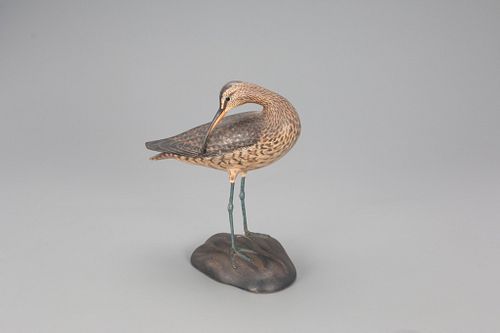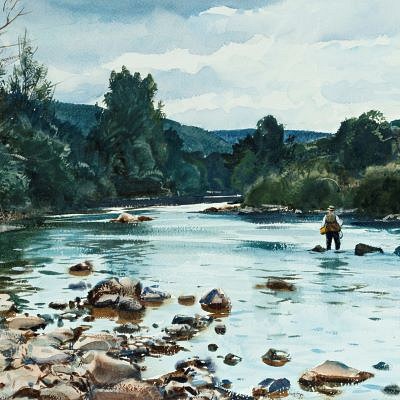The du Pont Preening Curlew, A. Elmer Crowell (1862-1952)
About Seller
20 Winter Street
Pembroke, MA 02359
United States
Founded in 2005, Copley Fine Art Auctions is a boutique auction house specializing in antique decoys and American, sporting, and wildlife paintings. Over the course of the last two decades, the firm has set auction records for not only individual decoy makers, but also entire carving regions. Copley...Read more
Two ways to bid:
- Leave a max absentee bid and the platform will bid on your behalf up to your maximum bid during the live auction.
- Bid live during the auction and your bids will be submitted real-time to the auctioneer.
Bid Increments
| Price | Bid Increment |
|---|---|
| $0 | $50 |
| $1,000 | $100 |
| $2,500 | $250 |
| $5,000 | $500 |
| $10,000 | $1,000 |
| $25,000 | $2,500 |
| $50,000 | $5,000 |
About Auction
Feb 20, 2021
Lots 293-596 Copley Fine Art Auctions cinnie@copleyart.com
- Lot Description
A. Elmer Crowell (1862-1952)
East Harwich, MA, 1941
9 in. long, 11 in. tall
Works like this curlew have been celebrated since their creation, with examples from Crowell's studio going to the mantles of the du Pont, Ford, Forbes, and Rockefeller families, among others. His decorative shorebirds were wildly popular among these early patrons of the arts and curlew took the lead. Today, the two top prices ever paid for decorative shorebirds at auction are both Crowell running curlew. The species, posture, execution, condition, rarity, and provenance of this du Pont Collection carving place it as one of the best decoratives to enter the market in some time.
This represents an exceedingly rare species in an exceptional pose by the "Father of American Bird Carving." A study of the maker's portfolio reveals that the preening posture is found in many of Crowell's most collectable pieces. Requiring a level of craftsmanship that few carvers have demonstrated, Crowell relished the challenges presented in both form and paint. In "Elmer Crowell: Father of American Bird Carving," authors O'Brien and Olney cite the carver's friend Joseph C. Lincoln who explains how the maker first began carving this posture: "...in filling one order from a wealthy customer, he let himself go. He made ducks with their heads turned backward, as ducks do turn their heads, when preening their feathers..."
This life-size mantle carving exhibits a graceful arching head accentuated by the perfectly curved bill. This feature spans high across the body to hover its bill just off of the primary feathers. The finest imported glass eyes are set within eye grooves above full cheeks, a feature not often seen in the maker's work. Crowell's attention to detail is remarkable with an incised mandible, nostrils, and tail feathers.
The bird's paint, gently blended, is an accurate portrayal of a curlew, also known as a whimbrel, exhibiting intricate feather detail with excellent wet-on-wet blending. While the final layer of paint was still wet, the maker applied contrasting-color delineations. Once the contrasting paint became tacky, he took a clean, dry brush and gently feathered the two colors together, producing his noteworthy blended effect. The maker's ability, coupled with his patience and high personal standards, enabled him to create the blended paint which subsequently became known as the Crowell style.
This base retains Crowell's elegant cursive signature on the underside reading "A. E. Crowell Cape Cod 1941." It is also marked with his rectangular stamp.
Excellent original paint with minimal wear, some touch-up to thigh putty and belly around thighs, a paint flake under the neck has been darkened, left foot is missing back toe.
Provenance: William K. du Pont Collection
Literature: Stephen B. O'Brien Jr. and Chelsie W. Olney, "Elmer Crowell: Father of American Bird Carving," Hingham, MA, 2019, pp. 144 and 148 and inside back cover, related carvings illustrated. Richard A. Bourne Co. Inc., "Rare American Decoys and Bird Carvings," July 13 and 14, 1982, lot 529, front cover, similar example illustrated.Please email condition report requests to colin@copleyart.com. Any condition statement given is a courtesy to customers, Copley will not be held responsible for any errors or omissions. The absence of a condition statement does not imply that the lot is in perfect condition.Condition
- Shipping Info
-
Copley Fine Art Auctions does not handle the shipping of any items. Shipping is the sole responsibility of the buyer. Once your payment has cleared and we have received your shipping form, items may be released for shipment. Copley Fine Art Auctions, LLC shall have no liability for any loss or damage to such items. Buyers should allow up to four weeks for shipment.
Please be aware that internet bidders may NOT not pick up their items at the sale. Items will be available for pick up by appointment or by shippers five days after the sale.
-
- Buyer's Premium



 EUR
EUR CAD
CAD AUD
AUD GBP
GBP MXN
MXN HKD
HKD CNY
CNY MYR
MYR SEK
SEK SGD
SGD CHF
CHF THB
THB


















